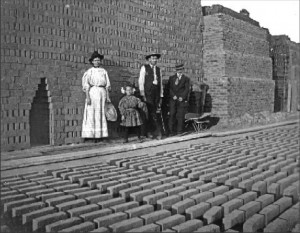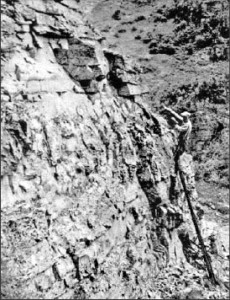by John Orr
It’s been a good water year so far
Streamflow in the Arkansas River kept most everyone happy this summer. The runoff came early and high flows were bolstered by a cool and wet beginning to the season and plenty of transmountain water. The above average boating season lasted well into August.
And the fish should be happy now as well. Most water resources operations are not moving much water as everyone is pretty much full. The lower flows during September and October help brown trout conserve energy for spawning later in the year. Less water means less current to fight. Greg Policky, aquatic biologist for the Colorado Division of Wildlife, told The Mountain Mail, “This is actually very favorable for the fish,” and added, “Flow between 250-400 cfs is optimum for fishing.”
By the end of July the Bureau of Reclamation had imported 82,000 acre-feet of water into the Arkansas Basin through the Boustead Tunnel which was considerably more than the 50,000 acre-feet projected in May. The tunnel diverts water from the Roaring Fork Basin and is part of the Fryingpan-Arkansas project.
In the San Luis Valley, Platoro Reservoir filled, boaters were able to use the San Luis Lakes and Medano Creek was flowing at Great Sand Dunes National Park. The Rio Grande was flowing at 70 percent of average at the beginning of September but Division III Division Engineer Craig Cotten was confident that the annual Rio Grande Compact obligation will be met easily using just return flows from irrigation, groundwater and municipal discharge.
A few San Luis Valley groundwater monitoring wells saw gains as much as 12 feet according to Cotten.
At the Monte Vista Wildlife refuge the U.S. Fish and Wildlife Service was spreading the news that, “We raised a lot of birds,” according to a report in the Valley Courier.
The Gunnison Basin did just fine over the summer as well. Blue Mesa Reservoir saw 772,000 acre-feet flow down the river between April and July. The May 1 forecast was just 690,000 acre-feet. May runoff was above average and the wet early summer boosted streamflow. The reservoir came to within three inches of spilling according to Bureau of Reclamation spokesman Dan Crabtree.
Rio Grande roundtable
According to a recent Colorado Foundation for Water Education poll, a strategy to promote sustainable water use is the top priority for the Rio Grande roundtable. They listed the protection of basin water as another goal.
Upper Arkansas Basin salinity study
Salinity is a problem for the lower Arkansas River valley so a coalition of water organizations – Pueblo, Aurora, Colorado Springs, the Southeastern Colorado Water Conservancy District and the Lower Arkansas Valley Water Conservancy District – are partnering with the U.S. Geological Survey to fund a study of salinity on the upper Arkansas River. According to a report in The Pueblo Chieftain two-thirds of the salt in the Arkansas is already present above Avondale and the major agricultural operations in the valley and is probably due to evaporative loss.
Nestlé Waters Chaffee County Project
After a ton of public comment which led to a long summer for all involved, Nestlé’s plan to truck water from the old Hagen trout hatchery spring to Denver for bottling, won approval from the Chaffee County Commissioners. The August 19 vote was 3-0 in favor of granting the permit.
Nestlé now has to meet some 40 plus requirements set by the county, including the hiring of local contractors and truck drivers. They will also be required to provide fishing access to the Arkansas River from the property.
Since the company will be trucking water tributary to the Arkansas River out of basin they have to replace the water in the river so they’ve signed a lease with Aurora. The commissioners are requiring Nestlé to stop pumping from the spring if low flows cause Aurora to use water downstream of Pueblo as a substitute supply for the lease so that the water will be release from Twin Lakes. The reservoir is upstream of the proposed pumphouse Nestlé plans to build. If the augmentation water came from, for example, water rights stored in Lake Pueblo, the Arkansas River would not see the flows in the reach between the project and Lake Pueblo.
Short takes
• In August Mount Princeton Geothermal LLC officials briefed the Upper Arkansas Water Conservancy District about their proposed test wells. The company hopes to solve the geology of the area with an eye towards picking a site for their geothermal electrical generation project that is not encumbered by groundwater tributary to the Arkansas River. They want to avoid the cost and hassle of augmentation. The company thinks that they’ll eventually be able to satisfy most of the electrical needs of the upper valley with a 10 megawatt plant.
• Del Norte is getting a major upgrade to their water system – new waterlines and meters.
• In August the Arkansas Basin roundtable approved a $180,000 to study water availability in the upper valley.
• The EPA has new plans for the California Gulch superfund site. Since the current facilities result in, at best, a 70% treatment rate for acid mine drainage through the EPA treatment plant, the agency is hoping to cap more tailings piles to reduce polluted flows.
• A new state law went into effect in August that encourages water rights holders to donate water to the Colorado Water Conservation Board for their instream flow program. The law provides a tax credit equal to 50% of the market value of the water.
• The Aurora city council approved the purchase of the Columbine Ditch in August. The ditch – which brings water into the Arkansas Basin from the Eagle River Basin – will be used to exchange against water Aurora has in storage in the upper valley.
• The Pueblo Board of Water Works has filed a water court application to triple the size of Clear Creek Reservoir near Grant.
• The proposed pipeline and effluent return leg project between Conifer and Bailey has slowed down now that Park County is processing Conifer Water LLC’s special use permit. Managing Partner John McMichael hopes to start construction in November. The pipeline will run from the North Fork of the South Platte to the Conifer area. The planned effluent return pipeline has a discharge point just downstream of the intake.
• Congratulations to Harris Sherman, Colorado’s Director of the Department of Natural Resources. Last month President Obama nominated Sherman to be Undersecretary of Interior in charge of the U.S. Forest Service.
John Orr follows Colorado water issues at Coyote Gulch (coyotegulch.net).

